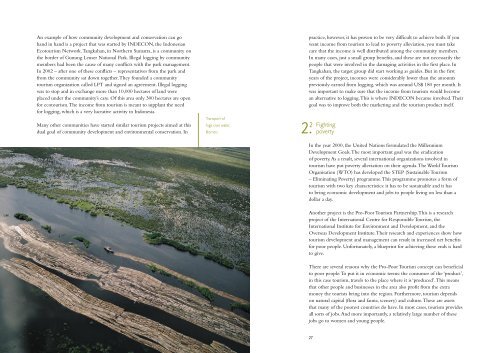OMSLAG 5.indd - IUCN
OMSLAG 5.indd - IUCN
OMSLAG 5.indd - IUCN
Create successful ePaper yourself
Turn your PDF publications into a flip-book with our unique Google optimized e-Paper software.
An example of how community development and conservation can go<br />
hand in hand is a project that was started by INDECON, the Indonesian<br />
Ecotourism Network. Tangkahan, in Northern Sumatra, is a community on<br />
the border of Gunung Leuser National Park. Illegal logging by community<br />
members had been the cause of many conflicts with the park management.<br />
In 2002 – after one of these conflicts – representatives from the park and<br />
from the community sat down together. They founded a community<br />
tourism organization called LPT and signed an agreement. Illegal logging<br />
was to stop and in exchange more than 10,000 hectares of land were<br />
placed under the community’s care. Of this area only 300 hectares are open<br />
for ecotourism. The income from tourism is meant to supplant the need<br />
for logging, which is a very lucrative activity in Indonesia.<br />
Many other communities have started similar tourism projects aimed at this<br />
dual goal of community development and environmental conservation. In<br />
Transport of<br />
logs over water,<br />
Borneo 2.<br />
2<br />
26 27<br />
practice, however, it has proven to be very difficult to achieve both. If you<br />
want income from tourism to lead to poverty alleviation, you must take<br />
care that the income is well distributed among the community members.<br />
In many cases, just a small group benefits, and these are not necessarily the<br />
people that were involved in the damaging activities in the first place. In<br />
Tangkahan, the target group did start working as guides. But in the first<br />
years of the project, incomes were considerably lower than the amounts<br />
previously earned from logging, which was around US$ 180 per month. It<br />
was important to make sure that the income from tourism would become<br />
an alternative to logging. This is where INDECON became involved. Their<br />
goal was to improve both the marketing and the tourism product itself.<br />
Fighting<br />
poverty<br />
In the year 2000, the United Nations formulated the Millennium<br />
Development Goals. The most important goal was the eradication<br />
of poverty. As a result, several international organizations involved in<br />
tourism have put poverty alleviation on their agenda. The World Tourism<br />
Organisation (WTO) has developed the STEP (Sustainable Tourism<br />
– Eliminating Poverty) programme. This programme promotes a form of<br />
tourism with two key characteristics: it has to be sustainable and it has<br />
to bring economic development and jobs to people living on less than a<br />
dollar a day.<br />
Another project is the Pro-Poor Tourism Partnership. This is a research<br />
project of the International Centre for Responsible Tourism, the<br />
International Institute for Environment and Development, and the<br />
Overseas Development Institute. Their research and experiences show how<br />
tourism development and management can result in increased net benefits<br />
for poor people. Unfortunately, a blueprint for achieving these ends is hard<br />
to give.<br />
There are several reasons why the Pro-Poor Tourism concept can beneficial<br />
to poor people. To put it in economic terms: the consumer of the ‘product’,<br />
in this case tourism, travels to the place where it is ‘produced’. This means<br />
that other people and businesses in the area also profit from the extra<br />
money the tourists bring into the region. Furthermore, tourism depends<br />
on natural capital (flora and fauna, scenery) and culture. These are assets<br />
that many of the poorest countries do have. In most cases, tourism provides<br />
all sorts of jobs. And more importantly, a relatively large number of these<br />
jobs go to women and young people.
















